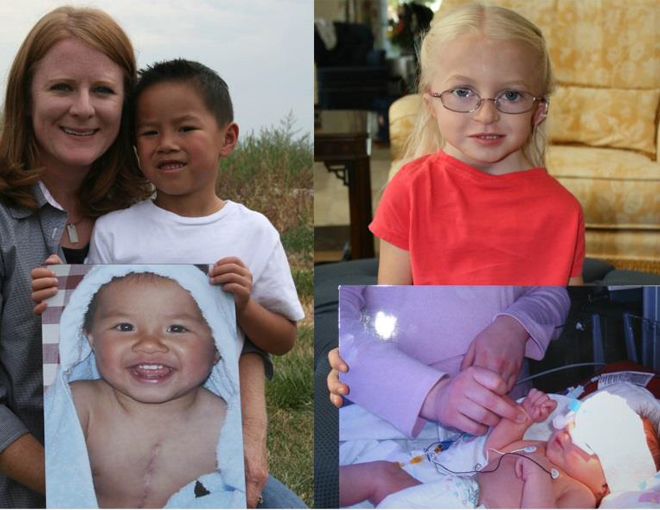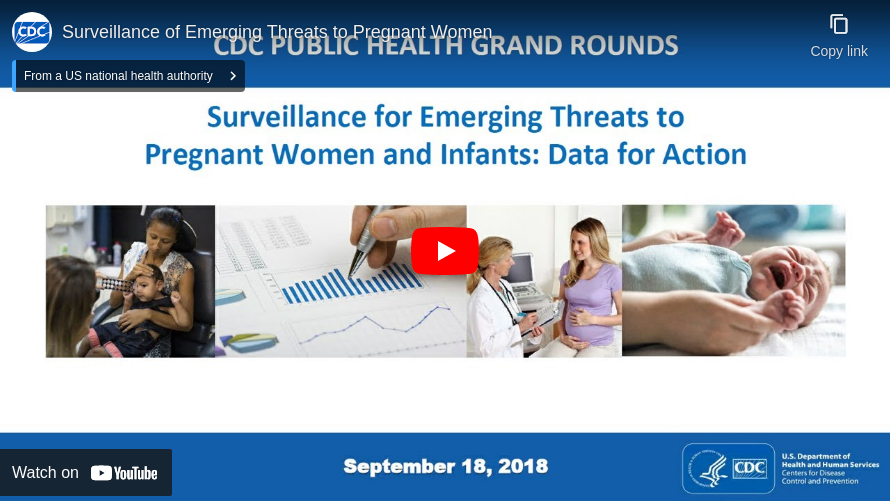Surveillance for Emerging Threats to Pregnant Women and Infants: Data for Action
Presented on .
The September session of Grand Rounds “Surveillance for Emerging Threats to Pregnant Women and Infants: Data for Action,” was viewed in 16 foreign countries and in 45 states, plus the District of Columbia.
Emerging health threats are a concern for everyone, yet pregnant women and infants are particularly vulnerable. For example, infection with the Zika virus or having untreated syphilis during pregnancy can cause a miscarriage or devastating birth defects. These birth defects may include brain abnormalities, misshaped bones and hearing loss. The timely identification and understanding of these emerging health threats and others, such as the opioid epidemic, allow communities to act early to protect mothers and babies.
This session of Grand Rounds will discuss how tracking birth defects and monitoring health outcomes of pregnant women and infants can help in prevention and treatment efforts by providing real-time information through surveillance.
Dr. Phoebe Thorpe and Dr. Michael Fraser discuss how data were used to protect women and infants during the Zika outbreak. The timely identification and understanding of these emerging health threats and others, such as the opioid epidemic, helps protect mothers and babies, yet challenges remain.
How does health care cost have implications on patient seeking care and followup?
Research has shown that financial costs can be a barrier to seeking care, specifically prenatal care (https://www.ncbi.nlm.nih.gov/books/NBK217704/). For babies and young children with developmental delays and disabilities, early intervention programs are available. These are services and support, which may include speech therapy, physical therapy, and other types of services based on the needs of the child and family. These programs are available in every state and territory. These publicly funded programs provide services for free or at reduced cost for any child who is eligible. For more information, visit: https://www.cdc.gov/ncbddd/actearly/parents/states.html.
How much do you think 'reporting bias' due to highly increased effort for data collection might have affected the results, especially in case of Zika?
Increased aware¬ness of birth defects potentially related to Zika virus infection in areas with local transmission might have resulted in increased efforts focused on rapid and complete identification of these birth defects cases during the second half of 2016. However, a significant increase in NTD prevalence was not observed. Although more complete ascertainment might partially explain the increased prevalence observed in areas with local transmis¬sion, it is unlikely that it would lead to a significant change, given the longstanding, mature surveillance systems, the standardized case review process, and no observable change in the prevalence of NTDs. https://www.cdc.gov/mmwr/volumes/67/wr/mm6703a2.htm.
- V. Fan Tait, MD, FAAP - Moderator
- Chief Medical Officer
- Ginny Bowen, PhD, MHS
- LCDR, U.S. Public Health Service
Epidemiologist
Epidemiology and Statistics Branch
Division of STD Prevention
National Center for HIV, Viral Hepatitis, STD, and TB Prevention
"Mind the Gap: Missed Opportunities to Prevent Congenital Syphilis"
- Mahsa Yazdy, PhD, MPH
- Director
Massachusetts Center for Birth Defects Research and Prevention
Massachusetts Department of Public Health
"Using Birth Defect Surveillance to Monitor Zika during Pregnancy"
- Sharon M. Watkins, PhD
- State Epidemiologist and Director
Bureau of Epidemiology
Pennsylvania Department of Health
"Adapting Zika Birth Defects Surveillance to Rapidly Monitor Neonatal Abstinence Syndrome"
- Dana Meaney-Delman, MD, MPH
- Acting Chief
Prevention Research and Translation Branch
Division of Congenital and Developmental Disorders
National Center on Birth Defects and Developmental Disabilities
"Emerging Health Threats: How Surveillance Can Inform Clinical Practice"
- John Iskander, MD, MPH
- Scientific Director
- Phoebe Thorpe, MD, MPH
- Deputy Scientific Director
- Susan Laird, MSN, RN
- Communications Director
Get notified about the latest updates from Public Health Grand Rounds right in your inbox by setting up an alert today!
Get notified about the latest updates from Public Health Grand Rounds right in your inbox by setting up an alert today!Sign Up
Get notified about the latest updates from Public Health Grand Rounds right in your inbox by setting up an alert today!
CDC Course Code: PHGR10
CPE UAN: 0387-0000-18-106-H04-P
For more information, see Grand Rounds Continuing Education.

Neural tube defects are serious birth defects and a major cause of death and lifelong disability worldwide. Up to 85 percent of neural tube defects can be prevented if women consume enough folic acid before and during early pregnancy. Find out how fortifying grains with folic acid could prevent these defects.

Birth defects are serious conditions that involve changes to the structure of one or more parts of the body. Learn about research that is underway to identify risk factors for birth defects, and to develop key intervention strategies that can be used to help ensure that every child is born in the best possible health.

